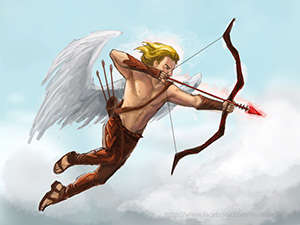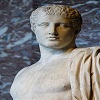Eros
God of Love
Eros was the Greek god of love, or more precisely, passionate and physical desire. Without warning he selects his targets and forcefully strikes at their hearts, bringing confusion and irrepressible feelings or in the words of Hesiod he ‘loosens the limbs and weakens the mind’.
Eros himself is a carefree and beautiful youth, crowned with flowers, especially of roses which were closely associated with the god.
According to Hesiod in his Theogony, Eros was one of the primeval gods who, along with Chaos and Gaia (Earth), were responsible for the Creation.
Here he perhaps represented a universal love. In other traditions he was the winged acolyte or assistant of the goddess Aphrodite, goddess of Love and Beauty.
He was also sometimes regarded as the child of Aphrodite, with Ares as his father, and his brothers were Deimos (Fear), Phobos (Panic), and Harmonia (Harmony). In some traditions Eros also had a younger brother - Anteros - who was a much darker figure and avenger of unrequited love.
It was thought that Eros’ arrows, often randomly aimed, made people fall in love. One of the most famous episodes involving this trick was when Apollo ridiculed the skills of Eros as an archer and the latter fired one of his arrows at the great god, making him fall in love with the nymph Daphne.
Another such instance of Eros using his love-carrying arrows was when he made Medea fall in love with the great hero Jason. The god was not himself immune to the powers of love and he famously fell for and married Psyche against the wishes of his mother Aphrodite.
Eros and his omnipotence was also a favourite subject of such philosophers as the Epicureans, Parmenides, and of Plato who discusses him at length in both his Symposium and Phaedrus.
In Greek religion he was the subject of cult worship in Thespiae (with its sporting and artistic festival, the Erotidia) and at Athens, Leuctra, Velia, and Parium. In addition, he was closely associated with many of the cults of Aphrodite. Altars to Eros were placed at both the Academy of Athens and the gymnasium at Elis.
In ancient Greek art from the 6th century BCE Eros is usually depicted as an adolescent with wings and he often carries a wreath of victory. He may also hold a lyre, a hare, or a whip, the latter when in pursuit of a youth.
He is only depicted carrying a bow with any great frequency from the 4th century BCE although the first literary reference is Euripedes’ Iphigenia Aulidensis (c. 548 BCE). On Greek pottery he usually appears in wedding and other romantic scenes, often hovering above the main protagonists such as Paris and Helen of Troy.
Athletic and military scenes may also include the impish god, and he regularly features in scenes of Aphrodite’s birth and the creation of Pandora, the first woman in Greek mythology.
Figures of Eros can also appear in twos or threes, when they are referred to as Erotes, symbolic of the different forms love can take. When in a group, these are often given the individual names of Eros, Himeros (Desire), and Pothos (Yearning).
Eros also famously appeared on the base of the throne of Zeus as part of the statue at Olympia which was one of the Seven Wonders of the Ancient World and he is present too on the east frieze of the Parthenon, shown as a child next to Aphrodite.
It is only in later Roman art that Eros, under his new name Cupid, is commonly portrayed unflatteringly as a rather chubby and mischievous baby.
[1]












